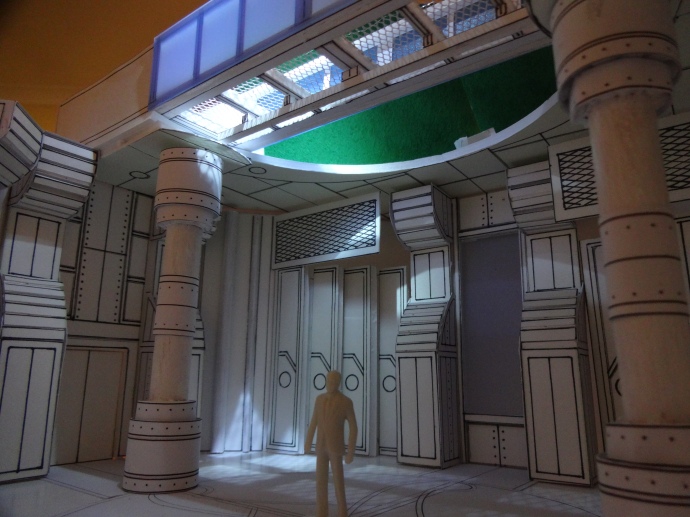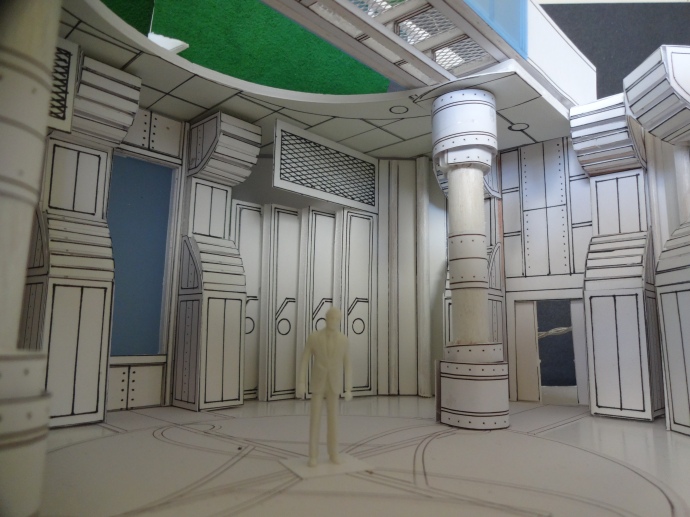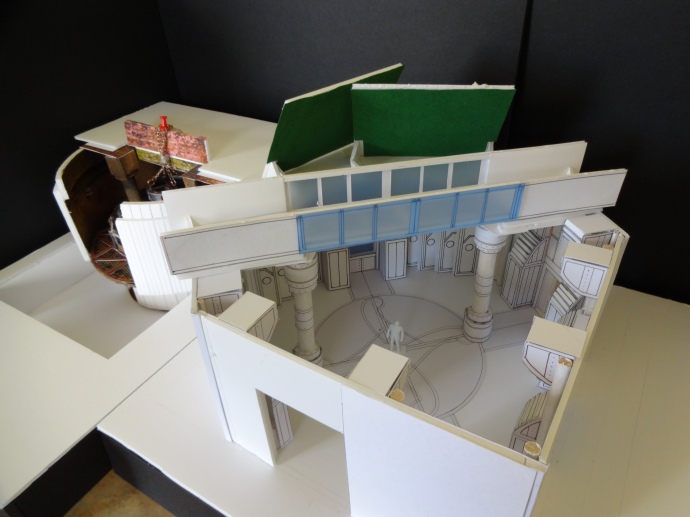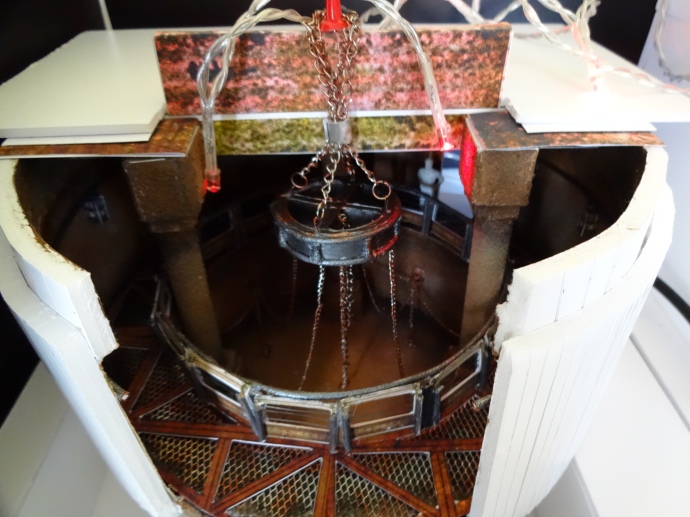I found an interview that shows what Guy Hendrix Dyas thinks about Production Design and the process as a whole. I have selected the parts of the interview that is most relevant to my question and project. The link for the full interview is found below in the references.
Angela Mitchell: Congratulations to you and your team on your BAFTA and many other awards for Inception! How did it feel to be nominated for an Oscar for the first time?
Guy Hendrix Dyas: It was exciting for us — it’s a rewarding experience, and it encourages everyone to keep producing the best work they can. It’s always nice to get a pat on the back from your peers. You have to learn to appreciate those moments.
Angela Mitchell: What do you think is the biggest misconception people have about being a production designer?
Guy Hendrix Dyas: The biggest misconception is that it’s simply about creating sets — production design is very abstract to those who don’t work in the film industry. In my experience, however, the designer is the director’s key ally when creating the look for a film, along with the director of photography. We’re asked to create much more than just sets, we create entire worlds and time periods. It’s very exciting.
Angela Mitchell: You started out doing industrial design, and then an incredible amount of work as an illustrator before concentrating on Production Design. Do you still ever use any of that industrial design foundation in your work today?
Guy Hendrix Dyas: I’m very grateful to have had solid training in industrial design before I even set foot in the film world. Not only did it allow me to develop a very practical design sense but it also made me strive for realism no matter the genre of film I’m working on — fantasy, historical, contemporary. That training was also a great way to learn everything there is to know about manufacturing and construction.
Angela Mitchell: When did you know that production design was going to be your calling?
Guy Hendrix Dyas: While in art school, I attended a film lecture series called “Grand Illusions,” and it opened my eyes to the behind-the-scenes of filmmaking, and the various careers open to those of us who come from a design background. I’ve always loved art and films, and as a student I was an avid filmgoer, seeing every movie I could, and always taking notice of the production design.
Angela Mitchell: When it comes to the work of other designers, which do you admire?
Guy Hendrix Dyas: I try and see every film I can, and a wide variety of genres, so there are many contemporary designers that I admire. From the large-scale designs of Ken Adam, Stuart Craig and Dante Ferretti, to the more intimate work of designers like David Gropman, Mark Friedberg,Timmy Yip and Ben van Os. But truthfully, it’s hard to name names because my list goes on…
Angela Mitchell: It seems to me that, just from reading the script, Inception would be a designer’s dream, a real playground. One of the many things I loved about your job for Inception, was how balanced it was, visually, between structure and chaos. How tricky was it to find that balance?
Guy Hendrix Dyas: Inception had many challenging sets to build, but it also offered us many wonderful design opportunities, while having to accommodate some extremely intricate action scenes and stunts.
For example, to create the illusion of weightlessness during the fight sequences in the hotel corridors and rooms, several identical sets had to be built. Each one was created for a specific shot and had a specific orientation and rotating capability. When these shots were edited together, they became convincing as appearing to have been shot on a single set.
With the scope of a film like Inception, also come the logistical challenges. We shot back to back in five different countries. We got used to the 16-hour days and being on planes every 48 hours!
Angela Mitchell: Was Escher’s work a deliberate inspiration for some of the Inception set pieces? What were some of your visual inspirations for the film?
Guy Hendrix Dyas: Escher and Penrose Staircase were directly referenced in our script. In the film, our Penrose steps are based on an optical illusion [the Penrose Staircase], made famous by Escher’s drawings — an ever-ascending staircase that can never be built or made functional in the real world.
Which is why it took us many hours of research and development to create the set that you see in the film. There’s practically no CG used to shoot the scene, just some support removal and clever camera work.
Angela Mitchell: Designwise, in Inception, it seemed to me that there was always this beautiful and very clear visual contrast between the linear and chaotic, and between tension and release — for instance, in the gorgeous hallway sequence you mentioned earlier, where Joseph Gordon-Levitt battles a bad guy in 360 degrees! What scene or moment presented your favorite challenge for the film?
Guy Hendrix Dyas: One of the most challenging sets to build was the snow fortress for the end sequence, because we chose to shoot it in a remote area in the high mountains of Calgary. Chris Nolan uses CG very cleverly and for Inception, he didn’t want a film primarily using digital backgrounds. So very early on, Chris and I made a crude clay model of this set, as he wanted to create something akin to what he’d seen in some of his favorite Bond films. That’s how we came up with a mix between military architecture and Panopticon prison design for the snow fortress, our concept being to never really know who is the observer and who is being observed.
It quickly became apparent to us that this set would have to be divided into two separate builds. The interiors would be built on stage in Los Angeles, while the multi-level exterior would be built at approximately 20,000 feet on a mountainous site we scouted in Calgary.
We started building the exterior set with a Canadian construction crew in late summer, right after returning from shooting in Morocco, in order to have it completed before the heavy snow set in for the winter. We were very conscious of this location’s natural beauty, so we avoided using concrete foundations. Instead, to anchor the set, we dropped large wood posts into foundations filled with water and let them freeze into place.
Angela Mitchell: It’s terrific that you were able to take such care for the natural environment there.
Guy Hendrix Dyas: Despite a few blizzards, we were really fortunate to have perfect weather conditions, and during the shoot you could actually see the real snow blowing across the set, and the amazing mountains behind it. It was a testament to how great it is to be able to shoot on location, with real conditions.
Angela Mitchell: Set decorator Douglas A. Mowat was also nominated alongside you for the Art Direction Oscar this year — how do the Production Designer and Set Decorator typically work together?
Guy Hendrix Dyas: A good example was the work we did on the Japanese castle sets. As per our script we knew that Saito, Ken Watanabe’s character in the film, would be imprisoned in a castle, but to me it made sense that it would be a Japanese castle. This gave my set decorating team and I a chance to create a subtle, dreamlike quality, especially when it came to choosing colors, materials, lighting and furnishings.
Angela Mitchell: There’s a definitely a richness, glow, and texture to all the scenes there. It’s very tactile.
Guy Hendrix Dyas: The hundreds of lanterns strung along the ceiling were based on something I’d seen in Japanese temples during certain traditional holidays. It was a way to add interest and warmth to this scene without cluttering the space. Our furnishings were minimal because the painted gold leaf murals and the glow from the lanterns were all that Japanese dining room really needed to come alive.
Angela Mitchell: What was it like to work with Christopher Nolan?
Guy Hendrix Dyas: It was a great experience, I learned a lot, and also felt I was given the freedom to contribute as many ideas as possible for each set. Chris is a great leader, and that’s what you need on a technically complicated film like Inception.
Angela Mitchell: What are the challenges involved when you’re designing for an existing franchise, like X2: X-Men United, Superman Returns, or Indiana Jones and the Kingdom of the Crystal Skull? I loved the way you managed to open up those worlds and give us these very different looks and feels, from the school attack in X2, to Lex Luthor’s yacht, to the inside of the pyramid in Indy…
Guy Hendrix Dyas: I think one of the most important goals of production design is to be able to satisfy a story and a director’s vision, so by definition this means that every film should be a completely new experience. Directors are really the ones guiding the way, and our aim is to bring their visions to life. Even when working on existing brands or franchises, I hope that my designs appear as different as the films and stories being told.
If there’s a constant, it’s perhaps the fact that every film is a learning process, and that for designers, it’s nice to be able to take each experience and the things you feel were the most successful into your next assignment — after a while, you start assembling your own personal bag of tricks.
Angela Mitchell: If you were going to advise a roomful of production design hopefuls, what would you say to them, and what mistakes would you caution them to avoid?
Guy Hendrix Dyas: I think we all make mistakes. That’s part of the learning process. But if you love your job on a day-to-day basis and you’re passionate about what you do, you’ll find a way to make it work.
Also, the challenges for me never come from the actual act of designing, but rather from the time and budget constraints. Although in many ways, smaller-budget films aren’t always harder to design than big-budget films.
Angela Mitchell: That’s really surprising.
Guy Hendrix Dyas: Because everything is proportional. A film that has ten times more money will usually have ten times more to create, and ten times the expectations to meet. Studios and producers simply don’t give you free money no matter the size of the production — everything is carefully accounted for, and bigger is rarely easier when it comes to films. I think that’s a common misconception.
Angela Mitchell: Do you typically sketch things out by hand in your design process, or on computer – or a combination of the two? What tools do you typically use?
Guy Hendrix Dyas: People in films seem to come from all walks of life, but in my case, the many years I spent at art and design school were very useful, as I draught, sketch, paint, sculpt and make models.
For each film, I sketch as much as possible — not only because I enjoy it as a design process, but because it’s still the best communication tool. Then, if time permits, I try to take my pencil sketches into color – however, more and more, I also work with a great team of illustrators who help me assemble the visuals we need.
Angela Mitchell: How do you approach each new film project — do you have a specific process each time?
Guy Hendrix Dyas: I think I approach each new film in the same way other designers do, in that I try and sketch out as many ideas as possible while also researching as much as possible – everything from the subject matter, to the architecture, to reading relevant books, watching documentaries, and visiting museums. I find those early days of preproduction very enjoyable, as you’re able to let your imagination run wild, and everything is still possible.
Angela Mitchell: Among the movies you’ve worked on, which were most satisfying for you, from an artistic standpoint, where you looked at the film and said, “That’s exactly what I wanted it to look like?”
Guy Hendrix Dyas: As your design credits accumulate, it’s true that one can start to discern patterns and preferences, but I’ve tried to avoid typecasting as much as possible. I’m excited by a variety of projects, and I think I’ve been able to break the mold by not always doing films considered to be big Hollywood films. Right after X2, for instance, I joined Terry Gilliam on The Brothers Grimm in Eastern Europe. I find those transitions healthy — every film is a new beginning.
Still, more often than not, the projects that come your way, and that you end up working on, are due to coincidence and lucky timing more than anything else. For me, every film is satisfying, it’s always as interesting and as visually pervading as you and the director want to it to be.
I feel very fortunate to say that all the films I’ve designed so far have brought me unique and wonderful experiences, and each in its own way has been my favorite. However, like many people in this industry, I try and keep my eyes on the road ahead — my hope is always that the best experiences are still to come.
“The biggest misconception is that it is simply about creating sets”
Dyas continues to confirm and also echoes some of the ideas of Alex McDowell in the fact that the role of the production design is abstract and doesn’t always work in a linear form. Again, it’s very much about world building and seeing the story as a whole.
“Chris Nolan uses CG very cleverly and for Inception, he didn’t want a film primarily using digital backgrounds. So very early on, Chris and I made a crude clay model of this set, as he wanted to create something akin to what he’d seen in some of his favorite Bond films.”
Another example of using traditional techniques in a technologically advanced film. They used a location to get the right feel and again used visual metaphors of being watched.
“Also, the challenges for me never come from the actual act of designing, but rather from the time and budget constraints. Although in many ways, smaller-budget films aren’t always harder to design than big-budget films.”
Here he discusses the budget, saying that the design is proportional to the size of film and budget. Budget will also play a large part in the production designers role at the early stages of film design. This will sometimes affect whether a set is built, location is used or a whole view is CGI. Titanic used a scale model to create a set, then CGI’d it in behind the actors instead of building a room for budget reasons. I had no budget to work with so designed the set to be built. This could of course been a CGI background or a model. Should the budget require that, It could easily be achieved using traditional methods of model making with advanced CGI to place the action into shot.
“I think I approach each new film in the same way other designers do, in that I try and sketch out as many ideas as possible while also researching as much as possible – everything from the subject matter, to the architecture, to reading relevant books, watching documentaries, and visiting museums ”
This is an important statement in terms of what the designer does at the pre-production stage in that the process is entirely immersive in terms of research.
It’s clear from what I have seen of Guy Hendrix Dyas’s work that he is involved from the start in what the film will look like right through to the set extensions and CGI. He provided a visual foundation for the overall design of the film, from researching the architecture through to locations, then on to how the CGI would be incorporated. Where traditional processes were needed or wanted, he was involved in their design. CGI is a tool like any other so providing that visual source material at the early stage of design is important in films that have so many concepts and needs to use multiple post-production techniques. Films like Science fiction and fantasy will always have challenges and having technology that speeds up the process can only be a good thing as it means the designer can oversee at the whole picture at a much faster pace. The important point to note is that post production/CGI etc. does not become a distraction and that it supports the design rather than becomes a way of life.
Interview references:-
(MITCHELL, A., Production Designer Guy Hendrix Dyas on the Challenges of ‘Inception’) Available at:-
(http://performingarts.about.com/od/Costumes/ss/Inception-Production-Designer-Talks-About-Designing-The-Films-Dreamscapes.htm) [Online: sourced on 17/05/14]































Recent Comments